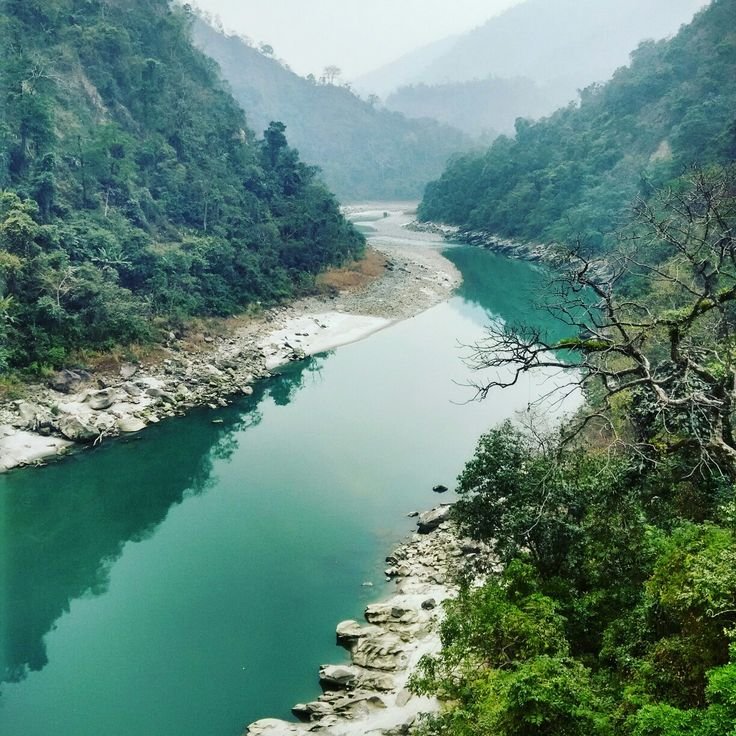Teesta River: The Contested Flow

The Teesta River is an India-Bangladesh river over which various forms of struggle and bargaining have occurred: for geopolitical tensions, environmental debate, and cultural storytelling. This river originates in the Eastern Himalayas and flows into the states of Sikkim and West Bengal in India before entering Bangladesh, joining up with the Brahmaputra River. The waters of the Teesta are vital for irrigation and the production of hydropower, apart from sustaining livelihoods, but management has led to high tensions between India and Bangladesh.

While sustaining agricultural and biodiversity processes, the construction of hydroelectric projects has involved a serious risk to this river’s natural flow, thus raising questions about its environmental sustainability.
Origin of the Teesta River
The Teesta River flows from Tso Lhamo Lake in the Sikkim Himalayas at an altitude above 5,300 metres. It flows southwards, cutting deep gorges through Sikkim, then into the plains of West Bengal, providing water for vast areas of the Terai region. About 315 km down, the river enters Bangladesh, where it forms part of the Jamuna River, a distributary of the Brahmaputra.
The Teesta has several important tributaries, coming from the Himalayan glaciers: Rangpo and Lachung rivers. These glacial streams ensure that there is a steady flow here but increases because of monsoon rains. Due to this, it is susceptible to floods. Over the years, climate change and deforestation within its watershed have increased variability within Teesta’s flow, causing both droughts and floods at different times of the year.

Mythology and Cultural Significance
Teesta is special in the folk and religious lore of the Himalayas. It is believed that Lord Shiva created the river as a heavenly stream to bless the people of the region. According to another version, Teesta was a form of Ganga, the river goddess who came from the mountains to nourish this land but remained there due to the trickery of other gods on the high peaks. According to regional folklores, it is often reported that due to the spontaneous nature of Teesta and the suddenness of her flow, she is often associated with playfulness or restlessness of the flow.
The river also has religious significance for the people of Sikkim and North Bengal. Many temples and shrines line its banks, and different rituals are being done by diverse communities on the waters of the Teesta with festivals. Folk songs, festivals, and literature have been shaped by the river; it has fashioned the identity of the people living in its course. The Teesta is supposed to be sacred in Sikkim. Traditional rituals have been performed for this river since the waters support life and agriculture.

Geopolitical Disputes between India and Bangladesh
The Teesta River was a hotly contested region between India and Bangladesh, both over water rights and other reasons. Bangladesh requires the waters of the river to irrigate its northern agricultural region, particularly the Rangpur area where rice, maize, and other crops are being cultivated. Taking a considerable portion of the flow from the river has created tension between the two countries through the Teesta Barrage Project in India for irrigation purposes in North Bengal.
Issues in the Dispute
- Water Allocation: Bangladesh has sought a reasonable share of Teesta River water during the dry season, saying that reduced flow would have a direct impact on agriculture and result in a food security threat. Indian authorities or more specifically, West Bengal, are not keen to share more with Bangladesh due to the drought in its region for irrigation purposes.
- Political tensions: Although India and Bangladesh signed an accord on water-sharing in 2011, the accord has not been implemented, primarily due to opposition from the state government of West Bengal. Bangladesh always pressures India to hasten the process for a resolution on this issue.
- Impact on Bangladesh’s Agriculture: In the dry season, the river flow is very poor and barely to an extent hence fails to provide the complete water supply for Bangladesh’s irrigation. The river has proved crop failures that resulted in more dependence of Bangladesh on groundwater supplies.

The Teesta River dispute, for instance, is a still-not-settled case of difficult water-sharing agreements in South Asia. In this region, numerous conflicting actors need to be managed for sustainable management. International diplomacy and cooperation between the two countries would play an important role in preventing such a conflict in the future.
Impact of Hydroelectric Projects on the Teesta River
The Teesta River’s natural flow has been considerably altered by the construction of hydroelectric projects along it. Hydroelectric projects exist along the river to meet power demands and supply irrigation for the nearby regions. However, these hydroelectric projects do have ecological and social costs.
Hydroelectric Projects
- Teesta-V Dam (Sikkim): The 510 MW project, operated by way of the National Hydroelectric Power Corporation (NHPC), is considered one of the largest dams on the river. While it offers energy to numerous states, it has disrupted fish migration styles and affected the livelihoods of fishing groups downstream.
- Lower Teesta Barrage (West Bengal): It is a part of an irrigation project intended to divert water for agriculture in North Bengal. The riparian benefits for farmers have resulted in reduced inflow into Bangladesh, straining the water-sharing equation.

Ecological and Social Impact
Hydropower projects on the Teesta River raise concerns about the loss of biodiversity, dislocation of affected communities, and environmental degradation. The construction of dams and barrages has altered the flow of the river, resulting in its erosion and siltation in the downstream areas, and often clearing tree cover along the riverbanks, which is an important habitat for wild animals.
Local communities are also affected by changes introduced by dams. Thousands of villagers have been displaced by hydropower projects while thousands of others have lost access to their traditional fisheries and farming along the rivers. In addition, monsoon floods are getting more intense due to the construction of reservoirs, generally disrupting the systems of local livelihoods and infrastructure in both India and Bangladesh.
Cultural and Ecological Significance in Sikkim and West Bengal
Beyond geopolitics, the Teesta is very crucial for the natural and cultural balance of the regions it passes through. It flows through dense forests, alpine meadows, and tea gardens in Sikkim. It houses so many kinds of migratory birds, fish species, and aquatic plants that the river assumes a very vital role in the region’s biodiversity.

Scenic landscapes make the Teesta River Valley an adventure tourism centre. Considering the rafting and kayaking opportunities, tourists flock there and thus add to the local economy of a region. These projects along Teesta also promote eco-tourism and facilitate conservation because of the sustainable tourism aspect while providing employment opportunities to people.
Teesta flows over the fertile plains of Terai. Agriculture is being supported and drinking water supply to several towns along the route is the source. Festivals and related traditional practices in Sikkim and North Bengal find their very core around this river as people are conceived to be strongly bonded with nature.
Conclusion
The Teesta River is an important source of life, livelihood, and identity for people in Sikkim, West Bengal, and Bangladesh. Yet, India and Bangladesh continue to view their shared river as a point of contention over water sharing. Some even urge both countries to talk and cooperate, equitably sharing the rivers while preserving ecological health.
Hydroelectric projects and barrages have been a means to regional development but have also changed the current system of the Teesta. Therefore, it has also been an environmental issue. The future security of the river will, on the whole, require a balance between economic growth and ecological conservation. Above all, climate change impacts will necessitate adaptive strategies to ensure sustainable water resource management.

The mythology of the Teesta, its ecological richness, and its cultural importance make the point clear that beyond politics, the Teesta also has a meaning for both India and Bangladesh. While the two countries work to establish a peaceful relationship, it is important that in this area, the Teesta should be viewed as more than a disputed resource. Instead, it is a lifeline both can use towards fostering cooperation, cultural exchange, and mutual prosperity. The Teesta may then proceed with a sustainable process for future generations, symbolizing unity and resilience.


